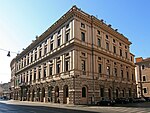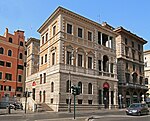Teatro Argentina
1732 establishments in the Papal StatesMusic venues completed in 1731Opera houses in RomeRome R. VIII Sant'EustachioTheatres completed in 1731

The Teatro Argentina ( which directly translates into theatre Argentina) is an opera house and theatre located in Largo di Torre Argentina, a square in Rome, Italy. One of the oldest theatres in Rome, it was constructed in 1731 and inaugurated on 31 January 1732 with Berenice by Domenico Sarro. It is built over part of the curia section of the Theatre of Pompey. This curia was the location of the assassination of Julius Caesar.
Excerpt from the Wikipedia article Teatro Argentina (License: CC BY-SA 3.0, Authors, Images).Teatro Argentina
Via di Torre Argentina, Rome Municipio Roma I
Geographical coordinates (GPS) Address Phone number Website External links Nearby Places Show on map
Geographical coordinates (GPS)
| Latitude | Longitude |
|---|---|
| N 41.895555555556 ° | E 12.476111111111 ° |
Address
Teatro Argentina
Via di Torre Argentina
00186 Rome, Municipio Roma I
Lazio, Italy
Open on Google Maps










